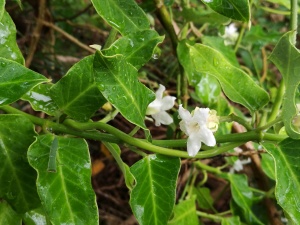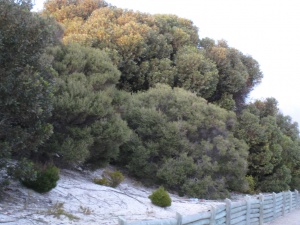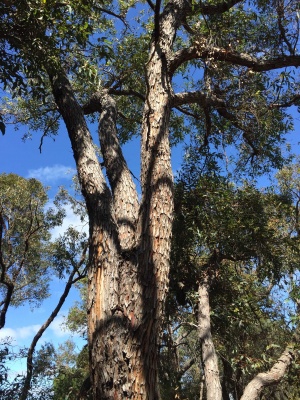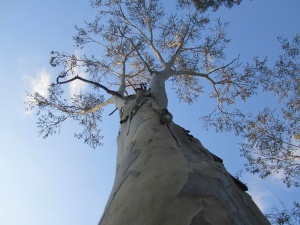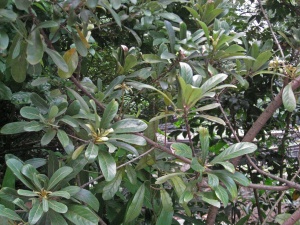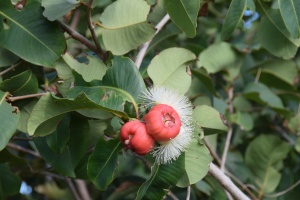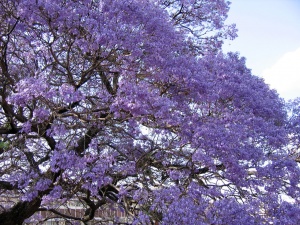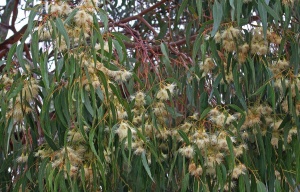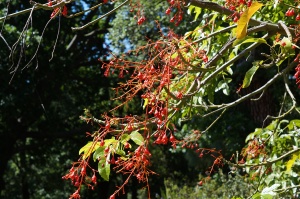Jen Sutfin
Moth Vine
A significant environmental weed in NSW and Queensland, and a minor environmental weed in Victoria and South Australia.
Also called ‘Cruel Plant’ as it catches butterflies and moths.
Green climber vine with green triangular leaves. It can grow up to 5 m long/high with clusters of pink-white flowers. Large green ribbed fruit resemble turn brown before splitting to shed masses of white cotton-like seeds.
Leaves
Green triangular to oval leaves 3 - 11 cm long and 1.5 - 6 cm wide with pointy ends and curling edges. Scattered hairs on upper surface with lower surface smooth with minimal fine hairs.
Flowers
Bell-shaped tubular flowers have five sepals (8 - 13mm long) and five petals (18 - 20 mm long) that are fused at the base. The tips of the sepals (calyx lobes) and petals (corolla lobes) are usually curved outwards or backwards. Flowers may be white or pale pink and sometimes have darker pink streaks in their throat. Flowers are borne in 2 - 5 flowered clusters (cymes), 2 - 2.5 cm diameter.
Moonah
Shrub or small tree to 10 m high with hard, rough bark, dark grey bark on a trunk that is often twisted and bent by the effects of wind. Bark hard, fissured, slightly papery or flaking.
Leaves
Arranged alternately, linear to narrow-elliptic, 5 – 15 mm long and 1 – 3 mm wide.
Flowers
White or cream coloured and arranged in many-flowered spikes 2–4 cm long.
Field Guide
Improve your identification skills. Download your Moonah field guide here!
Marri
Corymbia comes from Latin (corymbium) a "corymb" refers to floral clusters where all flowers branch from the stem at different levels but ultimately terminate at about the same level and calophylla comes from Greek (calo) beautiful, and (phyllon) a leaf.
Large tree with tessellated bark, up to 40 – 60 m high.
Leaves
Lance to oval shape. Veins are distinct.
Flowers
White to pink.
Manna Gum
There are 5 subspecies, 4 of which are found in Victoria. The species name viminalis means willowlike.
A tall tree, up to 40 - 50 m with smooth, white bark that peels in long ribbons. Rough at base.
Leaves
Adult leaves are long, narrow, bright green, glossy. Juvenile leaves are opposite, stalk-less, dull green, sword shaped.
Flowers
Not prolific, white flowers. Inflorescences (group of flowers) are axillary (arising from the meeting point of a leaf and a branch) on stalks 0.8 cm long, with 3 - 7 flowers per inflorescence.
Flower buds are oval to spindle-shaped, 5 - 9 mm long and 3 - 6 mm wide.
London Plane Tree
Deciduous tree, growing to 15 – 30 m high and 15 – 20 m wide. Some of its grey-brown bark peels off to reveal a creamy white inner bark, giving the trunk a mottled appearance.
Leaves
Mid-to-dark green with 3 – 5 lobes and slightly serrated edges. They are 10 – 25 cm across and turn yellow-brown in autumn. The leaf lobes are about as wide as they are long.
Flowers
Red or yellow, in small rounded clusters. The red (female) flowers grow from the newer shoots and the yellow (male) flowers grow from older branches further back toward the trunk.
Litsea
Fast growing deciduous tree that reaches 3 - 15m in height.
Also known as Brown Bollygum.
Leaves
Oblong shaped leaf blades that are clothes in white, erect hairs.
Flowers
Clusters of cream, green or yellow flowers appear along stems from March – June.
Lady Apple
Large, spreading tree, up to 14 m in height. Also know as Red Bush Apple.
Leaves
Variable in shape, oblong, ovate or lanceolate, usually large 7 - 19 cm long and 4 - 13 cm wide. Leaf midrib slightly grooved, depressed or flush with the upper surface.
Flowers
Large cream white brushes with long white stamens (pollen-containing anther) 13-48 mm long.
Jacaranda
Deciduous tree, not native to Australia. Grows up to 15 m high and wide.
Leaves
Bright green, feathery and fern-like. Individual leaves are narrow and elliptic, 3 – 12 mm long and arranged either side of a 5 – 10 cm long stem. They turn yellow in autumn before falling from the tree.
Flowers
Blue-purple and trumpet-shaped, forming clusters that are 20 – 30 cm in diameter. Each individual flower is 2 – 3 cm long and about 1 cm wide. They are lightly fragranced and remain on the tree for about 2 months.
There are four stamens inside the flower which produce pollen, and also a staminode which doesn’t produce any pollen.
Ironbark
Tree up to 35 m tall. The bark is rough over whole trunk and branches, thick, hard, grooved, black (ironbark).
Leaves
Juvenile leaves petiolate (have a stalk), are opposite for a few pairs then alternate, narrowly to broadly tapering to a point, to 17 cm long and 4 cm wide, more or less discolorous, green or greyish-green or glaucous (covered with a a greyish, bluish, or whitish powder or waxy coating).
Adult leaves petiolate, alternate, lance-head shaped, 9.5 – 22 cm long and 1 – 2 cm wide, concolorous (the lower leaf surface distinctly different in colour from the upper), green or glaucous; reticulation dense with numerous intersectional oil glands.
Flowers
It blooms producing inflorescences with flowers that are white, rarely pink. Keep an eye out for the flower caps that cover developing flowers and may fall on the ground at the end of flowering.
Illawarra Flame Tree
Deciduous tree, up to 35 m high, but much smaller when grown in gardens and in cooler areas where it reaches a height of only about 10 m. It can take 5 – 8 years to flower if grown from a seed.
Leaves
Smooth, oval-shaped and can have three or five lobes (and sometimes more). Each leaf is 10 – 30 cm long. The tree loses some or all of its leaves at the end of winter, before flowering, and the leaves turn yellow just before falling.
Flowers
Bright coral-red and bell-shaped, they occur in clusters at the end of branches. They are 1 – 2 cm long and have a waxy surface. They appear after the tree has lost all or some of its leaves.

